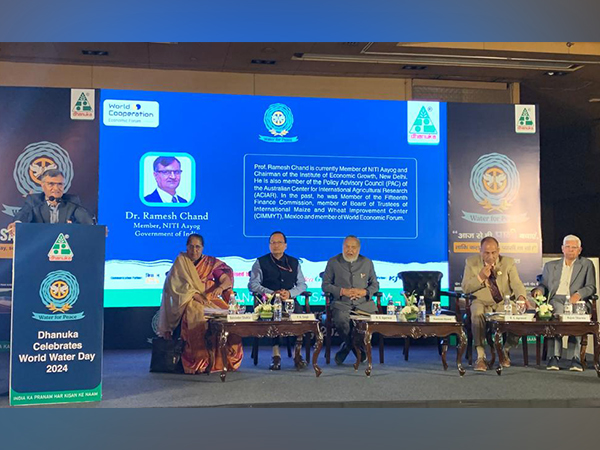India's water usage for per tonne crop production 2-3 times more than developed nations: Niti Aayog's Ramesh Chand
India uses two-to-threefold more water per tonne of crop compared to several developed and developing nations, and this must be reduced and state governments, in particular, should promote sustainable agricultural practices, said Professor Ramesh Chand, Member of government think tank Niti Aayog.

- Country:
- India
India uses two-to-threefold more water per tonne of crop compared to several developed and developing nations, and this must be reduced and state governments, in particular, should promote sustainable agricultural practices, said Professor Ramesh Chand, Member of government think tank Niti Aayog. While delivering a key note speech at a function organized in New Delhi on the occasion of World Water Day 2024 by plant protection company Dhanuka Group on Friday, the Niti Aayog member said that the area under cultivation in India has increased but mostly for Rabi crops, when it mostly does not rain.
"This needs to change and state governments in particular need to promote cultivation according to local environmental and geographical conditions," Professor Chand said, as per a press release. Paddy and sugarcane are two major water-guzzling crops, and India is a major producer of both these crops.
India has three cropping seasons -- Summer, Kharif, and Rabi. Crops that are sown during October and November and the produce harvested from January depending on maturity are Rabi. Crops sown during June-July and dependent on monsoon rains are harvested in October-November are kharif. Crops produced between Rabi and Kharif are Summer crops.
Highlighting the plight of the country's irrigation infrastructure before 2015, Professor Ramesh Chand further said billions of rupees were invested in irrigation projects - medium and major, but the area under irrigation remained stagnant. "Between 1995 and 2015, billions of rupees were invested on irrigation projects -medium and major, but area under irrigation remained stagnant. It required overhaul and since 2015, the Central Government changed the approach. As a result, the area under irrigation has increased by 1 per cent every year from last few years taking it from 47 per cent to 55 per cent now," he added.
PK Singh, Agriculture Commissioner for the government of India, putting emphasis on less investment intensive methods to increase area under irrigation using the same amount of water, said they were exploring ways to maximize the usage of surface water in collaboration with Jal Shakti ministry. "In collaboration with Jal Shakti ministry, we are exploring ways to maximize usage of surface water. For example, if water of a canal is presently irrigating 100 hectare of agricultural land, how can we take it to 150 hectare using various means but same amount of water," Singh added. (ANI)
(This story has not been edited by Devdiscourse staff and is auto-generated from a syndicated feed.)
ALSO READ
US Defense Secretary affirms commitment to bolster US-India partnership in Indo-Pacific to support allies' efforts.
Border blurs at Zero Point in Jhakuatari on Eid, as locals from India, Bangladesh gather for Namaz
Badminton Asia Championships: PV Sindhu, HS Prannoy ousted, India's campaign ends
"Want every Indian to see that video clip": Jewish woman of Indian-origin recalls losing loved ones to Hamas terrorists on Oct 7
US defence secretary reaffirms commitment to strengthening US-India partnership in supporting allies in Indo-Pacific region










